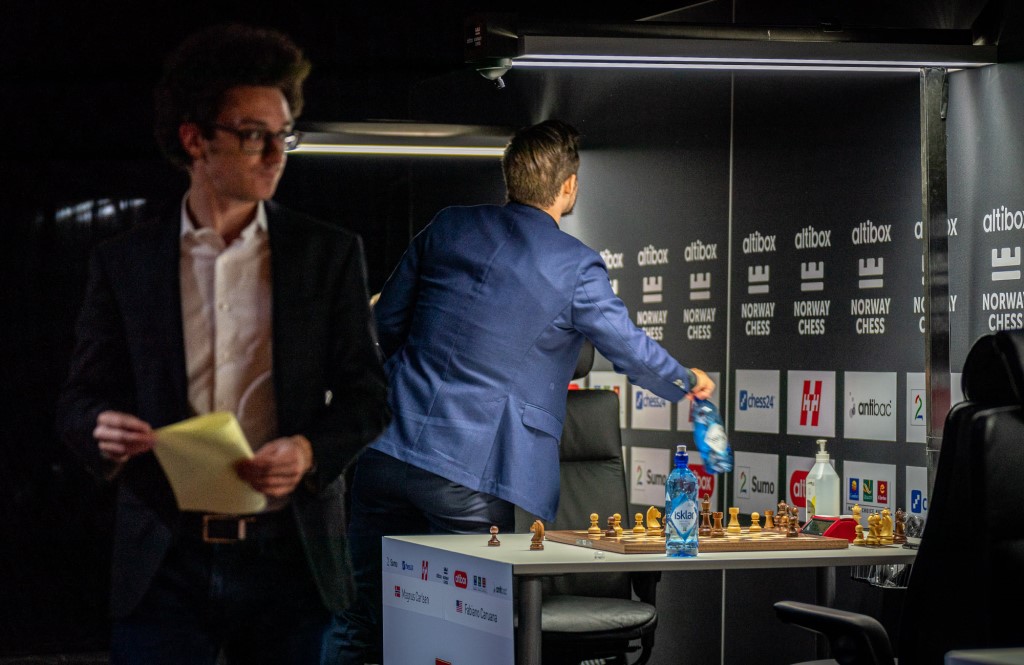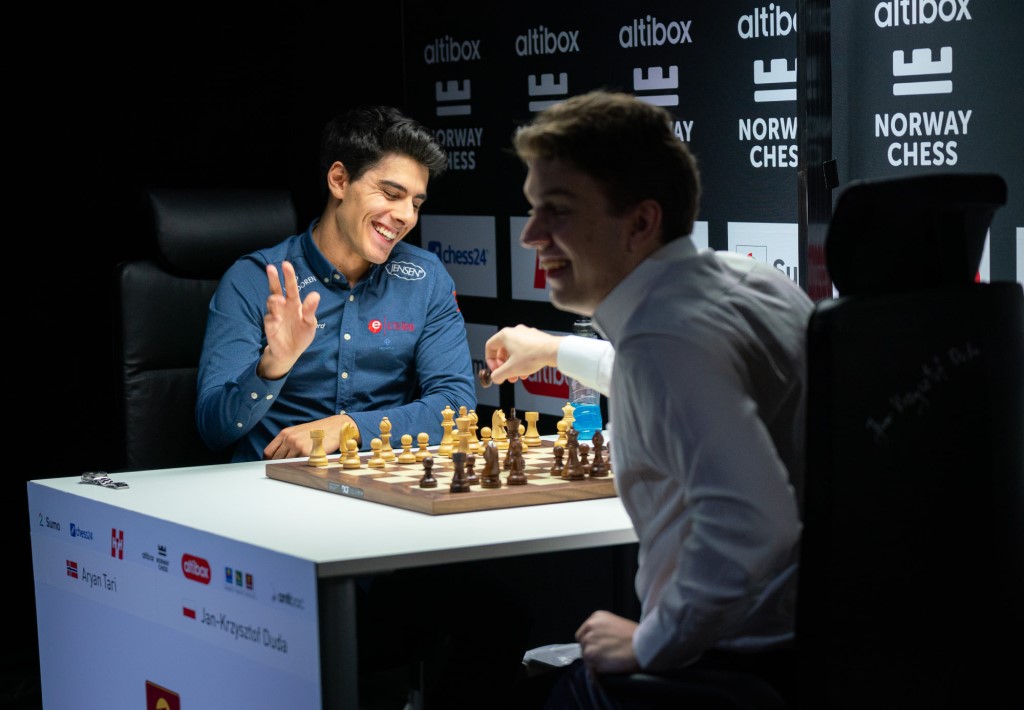


This is not the first time Magnus Carlsen shows a slow start in a tournament. He beat Levon Aronian and Alireza Firouzja in Armageddon to kick off the event, but his performance was not stellar, especially in the second matchup as he survived a losing position before beating the young Firouzja on time. In round 3, he faced Aryan Tari, had a dubious position out of the opening, and finally managed to outplay his young compatriot.
The biggest test for the world champion came in round 4, when he faced world number two and latest World Championship challenger Fabiano Caruana — the two strongest players in the world had drawn their previous 19 confrontations. Surprisingly, Carlsen did not need to work particularly hard to defeat the American, who, according to commentators and contenders, simply had an off day.
Carlsen commented:
This was probably the best position I had against him since the first game of the [2018 World Championsip] match, so it was obviously very sweet to get that win.
The remaining two classical games finished drawn. Firouzja beat Aronian and Tari beat Duda in Armageddon. Notably, a misunderstanding between arbiter Arild Rimestad and Firouzja meant the youngster arrived in the board two minutes late — he was playing black, so his clock went down from 7 to 5 minutes. A blitz and bullet specialist, Firouzja won the game nonetheless.

Namaste — world champion Magnus Carlsen | Photo: Lennart Ootes
Out of a Nimzo-Indian Defence, Caruana went for a line that led to a quiet game in which White had chances to push his small edge. Carlsen, known for handling these situations extremely well, started upping the pressure. Caruana’s decisive mistake came on move 30:
Kramnik, who also loved to squeeze from positions with slight advantages, thought Black needed to “pass” here with 30...Ke7, and White will need to find a precise plan to break through. Instead, Caruana’s 30...Rc6 gave White all he needed to slowly infiltrate until forcing his opponent to resign on move 51.
Caruana accepted it was “a bad game” for him, but at least he will get a chance to rest and recover before Saturday’s fifth round.

Caruana was not happy with his performance | Photo: Lennart Ootes
Throughout the four first rounds, Firouzja has shown his main weapon with black against 1.e4 is the Caro-Kann. Against Aronian, he had no major issues in the opening of the classical game and, although White seemed to have chances to fight for a small edge, Aronian decided to offer a draw on move 31. Kramnik noted, half jokingly, that apparently the best players in the world are starting to fear the 17-year-old!
As mentioned above, Firouzja arrived two minutes late to his game with black. It was another Caro-Kann, but this time around a messy position appeared on the board. White’s initiative on the kingside seemed to be bigger than Black’s initiative on the opposite flank. Aronian missed a chance to play a surprising winning manoeuvre on move 33:
33.Ndf5 was the killer shot, cutting off the a5-queen and opening up the long diagonal for the dark-squared bishop. Of course, this is not easy to find in a blitz game, and after Aronian’s 33.c5 it was Firouzja’s turn to miss a huge chance:
Kramnik found 33...Qxa2, winning with the lethal threat of mate on b1, while Firouzja later confessed that he did not even consider this move. Black played the defensive 33...g6 instead and the struggle continued. In the end, Firouzja fully controlled the situation against an opponent that needed a win at all costs. Firouzja thus secured his second straight win of the tournament — both achieved in Armageddon.

Alireza Firouzja talking with the arbiter | Photo: Lennart Ootes
With white, Norway’s number two Aryan Tari played aggressively on Friday. He got the upper hand in the classical game and did not shy away from going for the kill with a sacrifice in Armageddon:
Instead of getting a solid edge previously in the game, White went for it on the kingside and played 35.Nxf7 here. The engines do not approve, but given the situation it was a good practical choice — Kramnik and Polgar considered the sacrifice to be playable and thought it was an interesting decision.
From that point on, Tari was more tactically alert than his opponent and went on to score his first victory of the event.

Aryan Tari and Jan-Krzysztof Duda | Photo: Lennart Ootes
1. Carlsen 9
2. Aronian 8
3-4. Caruana, Firouzja 7
5. Tari 1.5
6. Duda 1
Jan-Krzysztof Duda – Magnus Carlsen
Alireza Firouzja – Aryan Tari
Fabiano Caruana – Levon Aronian